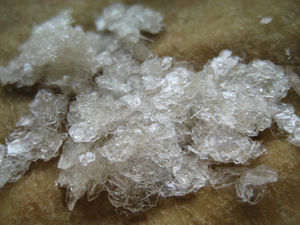Hydroxylammonium chloride
 Hydroxylamine HCl crystals
| |
| Names | |
|---|---|
| IUPAC name
Hydroxylammonium chloride
| |
| Other names
Hydroxyazanium chloride
Hydroxylamine chloride Hydroxylamine HCl Hydroxylamine hydrochloride Hydroxylammoniumchloride | |
| Properties | |
| [NH3OH]Cl NH2OH·HCl | |
| Molar mass | 69.49 g/mol |
| Appearance | White solid |
| Odor | Odorless |
| Density | 1.67 g/cm3 (20 °C) |
| Melting point | 154–156 °C (309–313 °F; 427–429 K) (decomposition) |
| 94 g/100 ml (25 °C) | |
| Solubility | Insoluble in hydrocarbons |
| Solubility in ethanol | 4.43 g/100 ml (20 °C)[1] |
| Solubility in methanol | 16.1 g/100 ml (20 °C)[2] |
| Hazards | |
| Safety data sheet | Sigma-Aldrich |
| Lethal dose or concentration (LD, LC): | |
| LD50 (Median dose)
|
642 mg/kg (rat, oral) |
| Related compounds | |
| Related compounds
|
Hydroxylammonium nitrate Hydroxylammonium sulfate |
| Except where otherwise noted, data are given for materials in their standard state (at 25 °C [77 °F], 100 kPa). | |
| Infobox references | |
Hydroxylammonium chloride or hydroxylamine hydrochloride ([NH3OH]Cl) is the hydrochloric acid salt of hydroxylamine.
Contents
Properties
Chemical
Hydroxylamine hydrochloride reacts with ketones to form oximes.
Heating hydroxylamine hydrochloride with sodium nitrite yields nitrous oxide.[3]
- NH2OH·HCl + NaNO2 → N2O + NaCl + 2 H2O
Physical
Hydroxylammonium chloride is a white solid, very soluble in water.
Availability
Hydroxylammonium chloride is sold by lab suppliers.
Preparation
Hydroxylammonium chloride can be prepared by reducing acidified potassium nitrite (aka nitrous acid) with potassium bisulfite, which yields hydroxylammonium sulfate. To obtain the chloride, barium chloride is added.[4]
Hydroxylamine hydrochloride can also be made by heating nitromethane with concentrated hydrochloric acid:
- CH3NO2 + HCl → NH2OH·HCl + 2 H2O + CO
This reaction is possible to do with the nitromethane/methanol azeotrope, however the yields are considerably lower.[5]
Projects
- Preparation of oximes and hydroxamic acids
- Make nitrous oxide
- Make glyoxime/diacetyldioxime and its red nickel complex
Handling
Safety
Hydroxylammonium chloride is an irritant to the respiratory tract, skin, eyes, and other mucous membranes. It is harmful if swallowed and may be absorbed through the skin. Hydroxylamine and its compounds are considered possible mutagen.
Storage
Hydroxylammonium chloride should be kept in closed plastic bottles, in a cool and safe place.
Hydroxylamine hydrochloride is stable up to 60 °C, above this temperature there will be significant degradation.[6]
Disposal
Hydroxylamine hydrochloride can be neutralized by using a ketone and then gently heating the resulting oxime, which reforms the ketone and releases nitrogen gas and water. It can also be neutralized by diluting it with water and carefully adding ferric salts or other compounds known to accelerate its decomposition.
Reduction of hydroxylamine with Zn/HCl yields ammonia.
Gallery
References
- ↑ Lobry de Bruyn, C. A.; Rec. Trav. chim.; vol. 10; (1891); p. 102
- ↑ Lobry de Bruyn, C. A.; Rec. Trav. chim.; vol. 10; (1891); p. 102
- ↑ https://www.youtube.com/watch?v=uzSe3BDCkF8
- ↑ https://www.prepchem.com/synthesis-of-hydroxylamine-hydrochloride/
- ↑ Henry, personal experience. Yield for hydrolysis was 29%
- ↑ Cisneros, Lizbeth O.; Rogers, William J.; Mannan, M. Sam; Thermochimica Acta; vol. 414; nb. 2; (2004); p. 177 - 183

